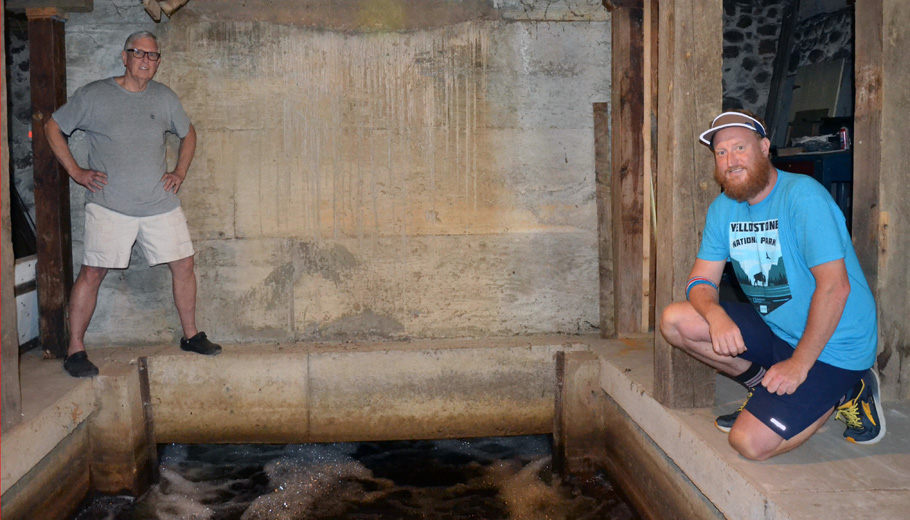
Iola Mills generates the juice
By James Card
Tom Fucik and Ed Lamar looked over Iola Lake and brainstormed ideas on how to handle the weeds.
A weed-cutting boat came through and the flotsam gathered into a floating mass at the gate of the head race. The weeds end up choking the water flow to the mill which in turn slows down the generation of electricity.
Their relationship is one of a mentor and apprentice as first- and second-generation hydropower operators. Lemar purchased Iola Mills from Fucik in January 2023 and he is now learning what it takes to keep the hydroelectric turbine in operation.
At a spot where the tail race enters the penstock there is a mound of aquatic weeds that farmers will later pick up for garden mulch. Throughout the summer Lemar goes there and rakes out weeds multiple times a day.
Fucik understands the toil and the commitment. At one point the weed raking was too much and he gave up and turned off the turbine. He couldn’t take it anymore but then he snapped out of his ennui and turned it back on. As the man who restored the mill and the hydropower, that was what he was called to do and he could not live to let such renewable energy go to waste. He went back to raking weeds.
Power by water
The evolution of the mill is like that of other Wisconsin towns. Settlers harnessed the power of water to build sawmills to convert the timber into lumber as the land was being cleared. Later on, these mills were converted to grind grain as farming took off.
The mill in Iola was no different. It started as a sawmill in 1853 and was converted to a grist mill for wheat and corn in 1860. A turbine for producing electricity was installed but it was a short-lived operation and small scale.
Fucik bought the place in 1996 and the last time the original turbine was used was in the 1950s. It was rebuilt and re-commissioned in 1999. It has been in operation ever since.
The turbine generates between 5 to 15 kilowatts depending on the water flow and time of year.
“In the spring melt when we have it fully open all the way, it’s making 15 (kW) or even a little more. It powers everything and then we sell some back to the utility as well. The cool thing about water power is that solar power only happens during the day, wind power only happens when it’s windy, but this thing is running all the time” said Lemar.
“Except when it’s down for maintenance,” said Fucik. “Or choked with weeds.”
Lemar groaned as the new gaurdian of the mill and the two of them commiserated for a moment on their shared hardship of keeping the head race cleared of the troublesome aquatic vegetation.
Tail race stories
Down in what could be considered the basement of the mill is the home of the turbine. Water pours in from the head race from Iola Lake and plunges into the penstock that holds the turbine and then it flows out in a tail race that resembles a cross between a trout stream and a lazy river tube float found at water parks.
When Fucik bought the mill in 1996 it was a quagmire.
“Everything was caving in. It was all muck and full of dead animals, hip flasks, wood and steel. I took out about 35 to 40 truckloads in a wheelbarrow. It was crazy,” he said.
Fucik laid drain tile and poured new concrete and brought it back a civilized condition. He walked over to a knee-high wooden box with a hinged lid. He flipped it open and inside was a hole about the same size as a toilet seat.
“There was a wood deck that went across [the flowing water] and this one-holer sat right in the middle. The old boys used to come down here and do their business and sent it all down to Scandinavia,” said Fucik.
An old timer that grew up in Iola came to visit the mill with this daughter. He told a story of when he was a boy, he and his friends would go fishing under the mill. One day he opened the lid of the rustic toilet and in the current was a brown trout. He got his fishing rod, hooked the fish and pulled it through the now two-way hole. His daughter never believed the story until it was verified that day.
Fish are attracted to the dark basement setting, the cool water and the forage getting flushed out of the penstock. Snapping turtles are common. While working on restoring the mill, Fucik would take swim breaks to cool off in the summer. One morning he witnessed a family of four river otters that cornered a large school of fish and the otters took turns protecting the escape route while one slaughtered and feasted on the trapped prey.
Fucik pointed out a strange-shaped metal device with two large balls. It was a centrifugal governor.
“Usually they used it to regulate speed. Here they used it to track speed,” he said as he pointed to a wooden gauge needle. “They had this set up to know how much power they were generating by the speed. The faster those iron balls go, the more the centrifugal force pulls them out. That’s where the saying, ‘Going balls out,’ originated from,” said Fucik.
